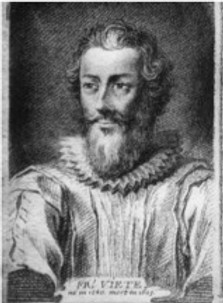The Most Influential
People in History

François Viète / vee EHT /
1540–1603
French Mathematician
Mathematics Ranking 23rd of 46

In algebra, François Viète took the first fundamentally new step after Diophantus by using literal notations for parameters as well as for the unknown.(1) Viète set down the foundations of this new science in his An Introduction to the Art of Analysis (In artem analyticem isagoge) in 1591. This enabled him to write equations and identities in general form. It is difficult to overestimate the importance of this step.(2) Mathematical formulas are not just a compact language for recording theorems. After all, theorems can also be stated in words; for example, the formula
(a + b)² = a² + 2ab + b²
can be expressed by means of the phrase “the square of the sum of two quantities is equal to the square of the first quantity, plus the square of the second quantity, plus twice their product.” Shorthand also has the virtue of brevity. What matters is that we can carry out operations on formulas in a purely mechanical manner and obtain in this way new formulas and relations. To do this you must observe three rules: 1) the rule of substitution; 2) the rule for removing parentheses; and 3) the rule for reduction of similar terms. For example, from the formula above one can obtain in a purely mechanical manner, without reasoning, formulas for (a + b + c)², for (a + b) , and so on. In other words, literal calculus replaces some reasoning by mechanical computations. One can hardly imagine mathematics without formulas, without a calculus. But it was such up until Viète’s time.
For addition and subtraction Viète adopted the German symbols + and – , and introduced the symbol = for the absolute value of the difference of two numbers; thus B = D is the same as |B – D|. Viète had not entirely broken away from his predecessors, however. He continued to use words or abbreviations for powers rather than exponents. Rather than using A2, B3, or C4, Viète wrote A quadratum, B cubus, or C quadrato-quadratum, the first and third of which he sometimes abbreviated to A quad or C quad-quad. For multiplication he uses the word “in”, A in B, and for division the word “applicare” or the fraction bar.
Viète’s next treatise, Ad logisticam speciosam notae priores, appeared only in 1646 as part of his collected works. In it he set down some of the most important algebraic formulas, such as:
(A + B)n = An ± nAn-1 B + · · · ± Bn, n = 2, 3, 4, 5;
An + Bn = (A + B) (An-1 – An-2 B + · · · ± Bn-1 ), n = 3, 5.
An – Bn = (A – B) (An-1 + An-2 B + B + · · · + Bn-1 ), n = 2, 3, 4, 5.
Viète’s literal calculus was perfected by René Descartes.(3) At the end of the 17th century a calculus was created for the analysis of infinitesimals (it was called for a long time the “algebra of the infinite”) One of its forms was Newton’s method of fluxions and infinite series (a generalization of polynomials!) and the other was the differential and integral calculus of Leibniz. Variational calculi and a calculus of partial differentials and derivatives were developed in the 18th century. A calculus of logic was created in the 19th century. Today, almost every mathematical theory has its own calculus (vector calculus, tensor calculus, and so on); furthermore, special calculi are created for individual problems, both theoretical and practical. The apparatus of formulas have become an indispensable language of mathematics. And its originators were Diophantus and Viète.(4)
Footnotes:
(1) Isabella Bashmakova and Galina Smirnova, translated from the Russian by Abe Shenitzer, The Beginnings & Evolution of Algebra (Washington, D.C., 2000), p. 77.
(2) Ibid., p. 77.
(3) Ibid., p. 79.
(4) Ibid., p. 80.
1
3